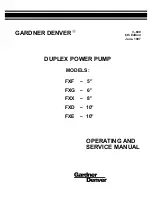
© EPS Stromversorgung in 2022, this information is subject to change without notice
74
30000800_manual_psb_10000_4u_30kw_en_04
3.11
The function generator
3.11.1
Introduction
The built-in
function generator
(short:
FG
) is able to create various signal forms and apply these to the set value of either
voltage or current.
The standard functions are based on an
arbitrary generator
and directly accessible and configurable using manual control.
In remote control, the fully customizable arbitrary generator replicates these functions with sequence points containing 8
parameters each.
Other functions, such as photovoltaics simulation, are based on an
XY generator
that works with a table of 4096 values
which are either loaded from a USB stick or calculated based upon adjustable parameters.
The following functions are retrievable, configurable and controllable:
Function
Short description
Sine
Sine wave generation with adjustable amplitude, offset and frequency
Triangle
Triangular wave signal generation with adjustable amplitude, offset, rise and fall times
Rectangular
Rectangular wave signal generation with adjustable amplitude, offset and duty cycle
Trapezoid
Trapezoidal wave signal generation with adjustable amplitude, offset, rise time, pulse time, fall time, idle
time
DIN 40839
Simulated automobile engine start curve according to DIN 40839 / EN ISO 7637, split into 5 curve se-
quences, each with a start voltage, final voltage and time
Arbitrary
Generation of a process with up to 99 freely configurable curve points, each with a start and end value
(AC/DC), start and end frequency, phase angle and total duration
Ramp
Generation of a linear rise or fall ramp with start and end values and time before and after the ramp
XY table
XY generator, USB stick loadable current curve (table, CSV)
PV table (PS)
PV EN50530
FC table (PS)
Functions to simulate a solar panel (PV function), also according to EN 50530, or fuel cell (FC function),
both with table calculation based upon adjustable parameters
Battery test
Battery charge and discharge test with constant or pulsed current, along with Ah, Wh and time counters
MPP tracking
Simulation of the characteristic tracking behavior of solar inverters when seeking to find the maximum
power point (MPP) when being connected to typical sources such as solar panels
3.11.2
General
3.11.2.1 Limitations
The function generator is not accessible, neither for manual access nor for remote control, if resistance mode (R mode, also
called UIR) is active.
3.11.2.2 Principle
The device features a built-in function generator (short: FG), but the entire unit can’t be considered as high power function
generator, because its power stages are only post-connected to the FG. Primarily in source mode, the typical characteristics
of a voltage and current source remain. Rise and fall times, caused by capacitor charge/discharge, affect the resulting signal
on the DC terminal. While the FG is able to generate a sine wave with 10000 Hz, the device will never be able to follow the
generated signal 1:1. Source and sink mode will slightly differ from each other regarding the results, while the sink mode will
be generally better, because primarily focused on current.
Depiction of principle:
Effect of the DC power stages on functions:
FG
PSB
DC
+
‐‐
C
The resulting wave on the DC terminal heavily depends on the frequency resp. period of the selected wave, its amplitude and
also the voltage rating of the device. The effect of the capacities on the wave can be partially compensated. In source mode
and when running voltage dynamics to which the capacities have the biggest impact on it can help to put an additional load
to the DC terminal in order to decrease rise and fall times. This extra load has a positive impact on periodic functions like
rectangle or sine wave.
















































